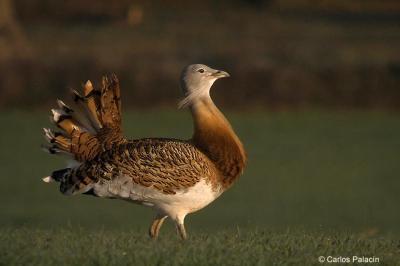Up until now it was unknown whether males of the great bustard (Otis tarda), an emblematic bird in Spain and endangered at a global level, transmit information on their weight, size, and age through their plumage. For the first time a study shows that the 'beards' and the design of the neck are "reliable" indicators of the weight and age of their bearers, and are used to both avoid fights with competitors and to attract females.
"The heaviest males (best physical condition) make it known to other males through the length and number of 'beards', and thereby avoid bloody fights to ascend in rank which would occur if these signals did not exist", Juan Carlos Alonso, main author and researcher in the Spanish National Museum of Natural Sciences (CSIC) informs SINC.
The study, which has been published in Ethology, shows for the first time that great bustard (Otis tarda) males achieve greater reproductive success and avoid "dangerous" and "unnecessary" confrontations due to the extent of development of their plumage. "Despite all this, sporadic fights do occur which lead to, on some occasions, the death of one of the contenders", says Alonso.
According to the scientist, when they are being chosen by the females, the oldest males "can compensate for a certain deficit in weight with greater experience thanks to their more advanced age".
Over a period of ten years, the researchers analysed wild specimens which were marked with transmitters to monitor the evolution over time of the colouring of their neck, and of the quantity and length of the 'beards' (feathers on both sides of the beak). The team verified that the changes in the plumage of the males were linked to changes in their reproductive success.

The success of male bustards is measured by their "beards."
(Photo Credit: Carlos Palacín)
In the past, "bearded bustards" were hunted for being old and for trophies, a practice which "probably contributed to eliminating many of the most successful specimens, rather than eliminating the senescent ones which do not reproduce", points out the biologist, who adds that this selective hunting could alter the demographic balance of populations.
The sexual dimorphism of bustards
60% of great bustard specimens, an emblematic bird of the Iberian fauna which is endangered at a global level, live in Spain. Their significant sexual dimorphism (difference in size between males and females), "the greatest in all birds and one of the highest amongst vertebrates", is the result of strong sexual selection, which forces the males to compete each year to ascend in the group's hierarchical ladder.
Added to this is their "markedly" polygamous nature: "more than half the males do no copulate, and only 10-15% of the best males obtain the majority of the copulations" explains Alonso. Despite the competition between the males, it is the females who ultimately select, from the best, "the one which will father their young".
To prove their dominant status to the rest of the males and to the females, the animals use, in addition to the features of the plumage, developed guidelines on sexual behaviour and wooing, notably the display of the lower part of the neck or 'gorget', "which swells up very attractively during mating, thanks to air sacs on the neck", explains the scientist.
The males of the majority of bird species have a wide range of colours and shapes in their plumage. They use these adornments against other males, in the same way many mammals with horns and tusks do.
Source: FECYT - Spanish Foundation for Science and Technology